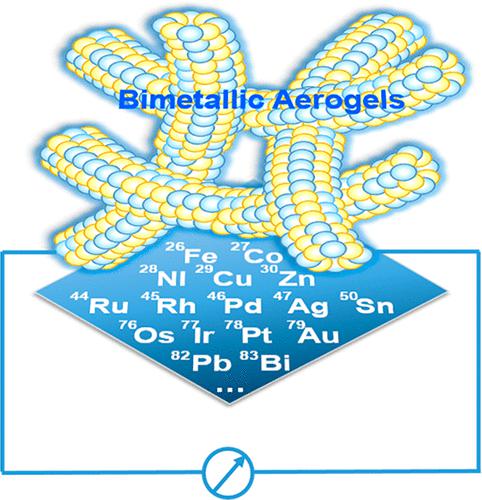当前位置:
X-MOL 学术
›
Acc. Chem. Res.
›
论文详情
Our official English website, www.x-mol.net, welcomes your
feedback! (Note: you will need to create a separate account there.)
Element Distributions in Bimetallic Aerogels
Accounts of Chemical Research ( IF 16.4 ) Pub Date : 2023-01-26 , DOI: 10.1021/acs.accounts.2c00491 Cui Wang 1 , Juan Herranz 2 , René Hübner 3 , Thomas J Schmidt 2, 4 , Alexander Eychmüller 1
Accounts of Chemical Research ( IF 16.4 ) Pub Date : 2023-01-26 , DOI: 10.1021/acs.accounts.2c00491 Cui Wang 1 , Juan Herranz 2 , René Hübner 3 , Thomas J Schmidt 2, 4 , Alexander Eychmüller 1
Affiliation

|
Metal aerogels assembled from nanoparticles have captured grand attention because they combine the virtues of metals and aerogels and are regarded as ideal materials to address current environmental and energy issues. Among these aerogels, those composed of two metals not only display combinations (superpositions) of the properties of their individual metal components but also feature novel properties distinctly different from those of their monometallic relatives. Therefore, quite some effort has been invested in refining the synthetic methods, compositions, and structures of such bimetallic aerogels as to boost their performance for the envisaged application(s). One such use would be in the field of electrocatalysis, whereby it is also of utmost interest to unravel the element distributions of the (multi)metallic catalysts to achieve a ratio of their bottom-to-up design. Regarding the element distributions in bimetallic aerogels, advanced characterization techniques have identified alloys, core–shells, and structures in which the two metal particles are segregated (i.e., adjacent but without alloy or core–shell structure formation). While an almost infinite number of metal combinations to form bimetallic aerogels can be envisaged, the knowledge of their formation mechanisms and the corresponding element distributions is still in its infancy. The evolution of the observed musters is all but well understood, not to mention the positional changes of the elements observed in operando or in beginning- vs end-of-life comparisons (e.g., in fuel cell applications).
中文翻译:

双金属气凝胶中的元素分布
由纳米颗粒组装而成的金属气凝胶因其结合了金属和气凝胶的优点而受到广泛关注,被认为是解决当前环境和能源问题的理想材料。在这些气凝胶中,由两种金属组成的气凝胶不仅显示出其各个金属成分的特性组合(叠加),而且还具有明显不同于其单金属亲属的新特性。因此,已经投入了相当多的努力来改进这种双金属气凝胶的合成方法、组成和结构,以提高它们在预期应用中的性能。其中一种用途是在电催化领域,因此,揭示(多)金属催化剂的元素分布以实现其自下而上设计的比例也是最令人感兴趣的。关于双金属气凝胶中的元素分布,先进的表征技术已经确定了合金、核壳和两种金属颗粒分离的结构(即相邻但没有合金或核壳结构形成)。虽然可以设想几乎无限数量的金属组合来形成双金属气凝胶,但对其形成机制和相应元素分布的了解仍处于初级阶段。观察到的集合的演变几乎是众所周知的,更不用说观察到的元素的位置变化了 先进的表征技术已经确定了合金、核壳和两种金属颗粒分离的结构(即相邻但没有合金或核壳结构形成)。虽然可以设想几乎无限数量的金属组合来形成双金属气凝胶,但对其形成机制和相应元素分布的了解仍处于初级阶段。观察到的集合的演变几乎是众所周知的,更不用说观察到的元素的位置变化了 先进的表征技术已经确定了合金、核壳和两种金属颗粒分离的结构(即相邻但没有合金或核壳结构形成)。虽然可以设想几乎无限数量的金属组合来形成双金属气凝胶,但对其形成机制和相应元素分布的了解仍处于初级阶段。观察到的集合的演变几乎是众所周知的,更不用说观察到的元素的位置变化了 它们的形成机制和相应的元素分布的知识仍处于起步阶段。观察到的集合的演变几乎是众所周知的,更不用说观察到的元素的位置变化了 它们的形成机制和相应的元素分布的知识仍处于起步阶段。观察到的集合的演变几乎是众所周知的,更不用说观察到的元素的位置变化了在操作数或开始与结束寿命比较中(例如,在燃料电池应用中)。
更新日期:2023-01-26
中文翻译:

双金属气凝胶中的元素分布
由纳米颗粒组装而成的金属气凝胶因其结合了金属和气凝胶的优点而受到广泛关注,被认为是解决当前环境和能源问题的理想材料。在这些气凝胶中,由两种金属组成的气凝胶不仅显示出其各个金属成分的特性组合(叠加),而且还具有明显不同于其单金属亲属的新特性。因此,已经投入了相当多的努力来改进这种双金属气凝胶的合成方法、组成和结构,以提高它们在预期应用中的性能。其中一种用途是在电催化领域,因此,揭示(多)金属催化剂的元素分布以实现其自下而上设计的比例也是最令人感兴趣的。关于双金属气凝胶中的元素分布,先进的表征技术已经确定了合金、核壳和两种金属颗粒分离的结构(即相邻但没有合金或核壳结构形成)。虽然可以设想几乎无限数量的金属组合来形成双金属气凝胶,但对其形成机制和相应元素分布的了解仍处于初级阶段。观察到的集合的演变几乎是众所周知的,更不用说观察到的元素的位置变化了 先进的表征技术已经确定了合金、核壳和两种金属颗粒分离的结构(即相邻但没有合金或核壳结构形成)。虽然可以设想几乎无限数量的金属组合来形成双金属气凝胶,但对其形成机制和相应元素分布的了解仍处于初级阶段。观察到的集合的演变几乎是众所周知的,更不用说观察到的元素的位置变化了 先进的表征技术已经确定了合金、核壳和两种金属颗粒分离的结构(即相邻但没有合金或核壳结构形成)。虽然可以设想几乎无限数量的金属组合来形成双金属气凝胶,但对其形成机制和相应元素分布的了解仍处于初级阶段。观察到的集合的演变几乎是众所周知的,更不用说观察到的元素的位置变化了 它们的形成机制和相应的元素分布的知识仍处于起步阶段。观察到的集合的演变几乎是众所周知的,更不用说观察到的元素的位置变化了 它们的形成机制和相应的元素分布的知识仍处于起步阶段。观察到的集合的演变几乎是众所周知的,更不用说观察到的元素的位置变化了在操作数或开始与结束寿命比较中(例如,在燃料电池应用中)。











































 京公网安备 11010802027423号
京公网安备 11010802027423号